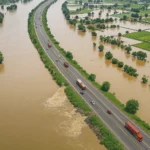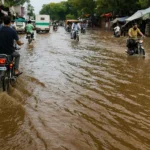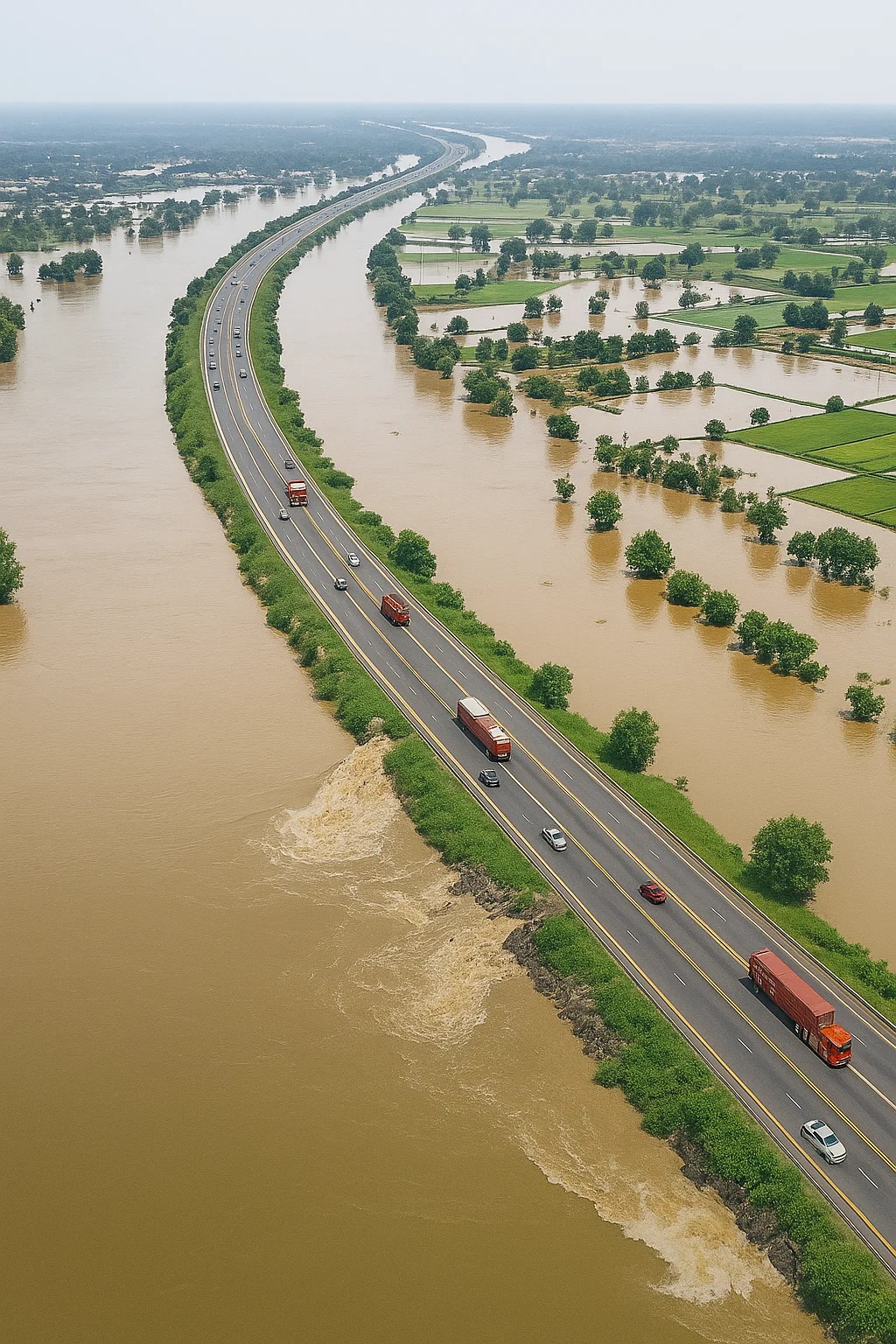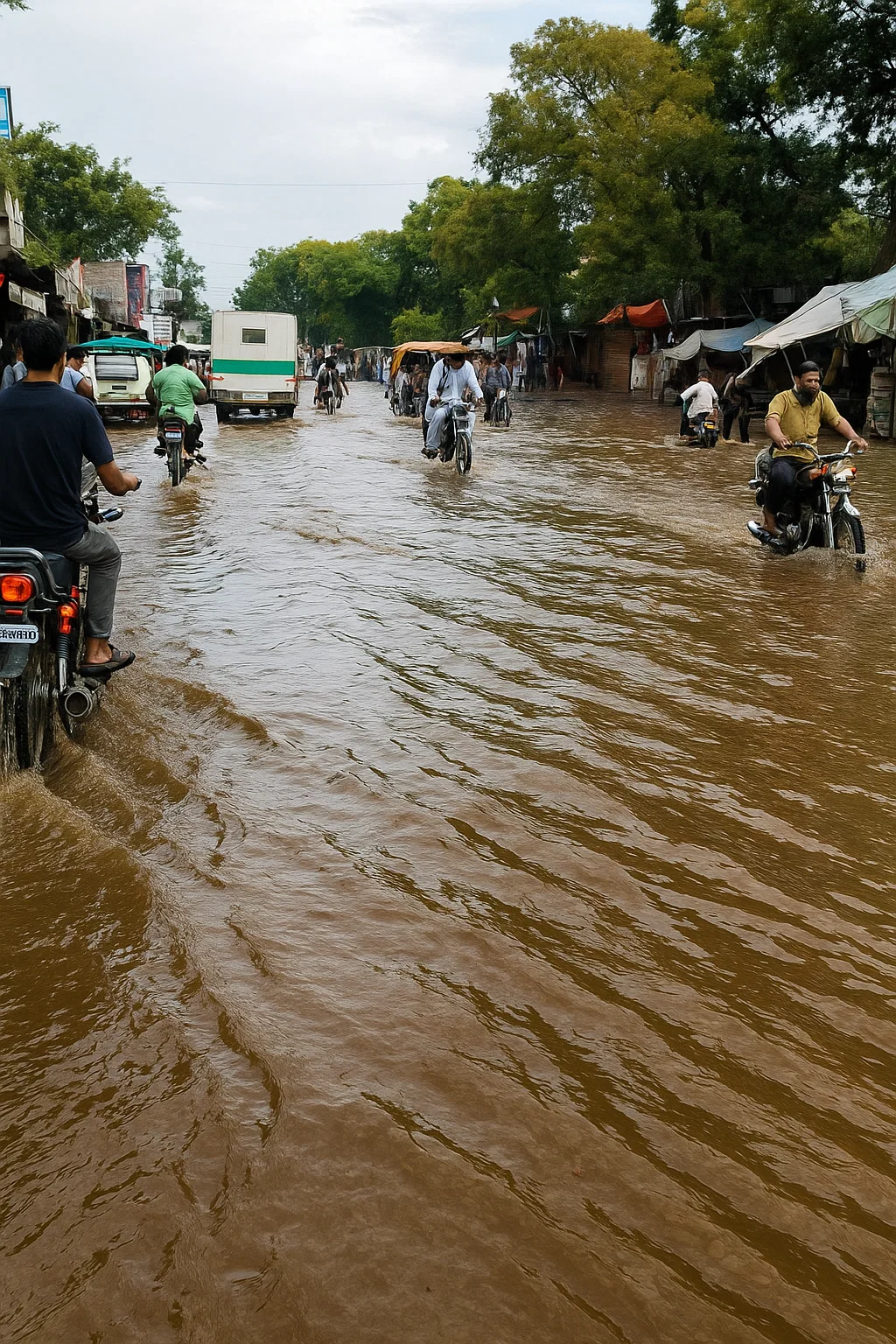Punjab Floods Catastrophe: India’s Water Release Worsens Crisis.Pakistan is facing a severe flood situation as Punjab Floods intensify following India’s release of water in relays, raising concerns over the impact on downstream areas. Planning Minister Ahsan Iqbal on Wednesday accused India of worsening the floods by not sharing timely information under the Indus Water Treaty, which could have helped Pakistan prepare for the surge in water.
The situation has triggered a nationwide response, with federal and provincial authorities coordinating relief and rescue operations across the province.
Rising River Levels Trigger Punjab Floods
Inter-Services Public Relations (ISPR) Director General Lieutenant General Ahmed Sharif Chaudhry informed the media that three rivers in Pakistan—Sutlej, Chenab, and Ravi—are experiencing high flows, contributing to the worsening Punjab Floods. The army has been deployed for immediate rescue operations in affected areas, demonstrating a rapid and coordinated response.
He was joined by Information Minister Attaullah Tarar and NDMA Chairman Lieutenant General Inam Haider Malik, highlighting the seriousness of the situation. Troops and officers are actively engaged, providing assistance and support to the affected population.
Rescue Efforts Underway
Rescue operations are being carried out in multiple flood-hit areas of Punjab. In Kartarpur, boats are being used to evacuate stranded individuals, while efforts to reopen critical routes like the Karakoram Highway are ongoing.
Tarar emphasized that the Sutlej, Chenab, and Ravi rivers are facing critically high flows, with water at Head Khanki surpassing one million cusecs. Authorities are maintaining constant communication with provincial administrations, enabling timely evacuations that have helped reduce potential casualties during the ongoing Punjab Floods.
National Response and Coordination
Prime Minister Shehbaz Sharif chaired a meeting focused on the flood situation, directing authorities to accelerate relief efforts. Tents, food supplies, and emergency assistance are being distributed across affected areas.
Tarar stressed that the response to the Punjab Floods is a “national effort,” with both federal and provincial institutions working together. The immediate focus remains on rescue and relief, while losses will be assessed later to plan rehabilitation measures.
READ MORE:
https://freedompakistan.com.pk/it-exports/
Kartarpur Corridor and Pilgrimage Sites Affected
Approximately 200–300 people were stranded in the Kartarpur Corridor on Wednesday morning. The armed forces have been called in to assist with evacuations. Visuals from the area showed Gurdwara Darbar Sahib in Narowal District submerged after the Ravi River overflowed.
Officials from the Evacuee Trust Property Board reported that floodwater entered the shrine’s compound, reaching nearly three feet in some areas. Courtyards and main staircases were inundated, temporarily halting pilgrim visits. Authorities stated that the shrine would reopen only after drainage and cleanup operations are completed, highlighting the impact of the Punjab Floods on cultural and religious landmarks.
Relief and Rescue Operations
The Pakistan Army has been actively involved in relief operations across six districts of Punjab since last night. State-run PTV reported that other disaster management organizations, including the National Disaster Management Authority (NDMA), Provincial Disaster Management Authority (PDMA), and Rescue 1122, are also engaged in response efforts.
Provincial and federal authorities confirmed that nearly 190,000 people have been evacuated so far, with the military assisting in the relocation of residents from dozens of submerged villages. Punjab Floods have affected towns and villages across Lahore, Faisalabad, Okara, Kasur, Sialkot, and Narowal. Towns along the Sutlej River, including Kasur and Ganda Singh Wala, are among the most severely impacted.
Evacuations and Safety Measures
Troops are transporting flood-affected individuals to safer locations using boats. The evacuation prioritizes children, women, and the elderly, ensuring their safety during the ongoing Punjab Floods. Soldiers are also helping move residents’ belongings and livestock to secure areas.
Relief camps have been established by the Pakistan Army and district administrations to provide temporary shelter, food, and medical support to displaced populations.
Scale of Punjab Floods Impact
Officials from Rescue 112 confirmed that at least 32,589 people have been evacuated from flood-prone areas across Punjab. Critically high water levels in major rivers and reservoirs have triggered large-scale rescue operations, with thousands relocated from vulnerable areas along the Indus, Chenab, Ravi, Sutlej, and Jhelum rivers.
The Punjab Floods are not only affecting urban centers but also rural communities, where flooding has submerged homes, roads, and farmland. The scale of the crisis underscores the urgency for timely interventions and robust disaster management strategies.
Government and Military Response
Federal and provincial authorities are closely monitoring the Punjab Floods, coordinating efforts to minimize damage and ensure public safety. Prime Minister Shehbaz Sharif and senior officials are overseeing relief operations and facilitating resource allocation for flood-affected districts.
The Pakistan Army, NDMA, PDMA, and Rescue 1122 continue to work together to manage evacuations, distribute supplies, and provide medical aid. Their coordinated efforts are critical in addressing both immediate needs and long-term recovery challenges caused by the Punjab Floods.
Public Awareness and Safety Measures
Authorities have issued warnings to residents in flood-prone areas, advising them to evacuate and avoid unnecessary travel. Public awareness campaigns, combined with timely evacuations, have helped reduce the risks associated with Punjab Floods.
Citizens are urged to follow official guidance, stay informed about river levels, and cooperate with rescue teams to ensure their safety.
Conclusion: Punjab Floods Demand Immediate Action
The ongoing Punjab Floods have severely impacted the province, affecting millions and inundating towns, villages, and key infrastructure. While federal and provincial authorities, along with the Pakistan Army, continue relief and rescue efforts, timely planning, coordination, and public cooperation remain essential.
As waters rise across the Sutlej, Chenab, Ravi, Indus, and Jhelum rivers, the Punjab Floods situation underscores the importance of disaster preparedness, national solidarity, and effective water management. The coming days will be crucial in managing evacuations, providing relief, and beginning rehabilitation efforts to restore normalcy in affected areas.












